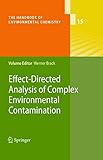Effect-Directed Analysis of Complex Environmental Contamination / edited by Werner Brack.
Tipo de material: TextoSeries The Handbook of Environmental Chemistry ; 15Editor: Berlin, Heidelberg : Springer Berlin Heidelberg, 2011Descripción: xviii, 346 páginas recurso en líneaTipo de contenido:
TextoSeries The Handbook of Environmental Chemistry ; 15Editor: Berlin, Heidelberg : Springer Berlin Heidelberg, 2011Descripción: xviii, 346 páginas recurso en líneaTipo de contenido: - texto
- computadora
- recurso en línea
- 9783642183843
- GE1-350
Springer eBooks
Early Evolution of the Toxicity Identification Evaluation Process: Contributions from the United States Environmental Protection Agency Effluent Testing Program -- Recent Developments in Whole Sediment Toxicity Identification Evaluations: Innovations in Manipulations and Endpoints.-Considerations for Incorporating Bioavailability in EDA and Toxicity Identification Evaluation -- Diagnostic tools for EDA of mutagens, AhR agonists and endocrine disruptors -- Separation Techniques in EDA -- Simultaneous screening and chemical characterization of bioactive compounds using LC-MS based technologies -- Advanced GC-MS and LC-MS tools for structure elucidation in effect-directed analysis -- Computer Tools for Structure Elucidation in EDA -- EDA of mutagens in ambient airborne particles -- EDA of endocrine disruptors in aquatic ecosystems -- ED studies of pulp and paper mill effluents -- EDA of Ah-receptor mediated toxicants, mutagens and endocrine disruptors in sediments and biota -- Ecological relevance of key toxicants in aquatic systems.
Today more than 5 million chemicals are known and roughly 100,000 of them are frequently used, with both numbers rising. Many of these chemicals are ultimately released into the environment and may cause adverse effects to ecosystems and human health. Effect-directed analysis (EDA) is a promising tool for identifying predominant toxicants in complex, mostly environmental mixtures combining effect testing, fractionation and chemical analysis. In the present book leading experts in the field provide an overview of relevant approaches and tools used in EDA. This includes diagnostic biological tools, separation techniques and advanced analytical and computer tools for toxicant identification and structure elucidation. Examples of the successful application of EDA are discussed such as the identification of mutagens in airborne particles and sediments, of endocrine disruptors in aquatic ecosystems and of major toxicants in pulp and paper mill effluents. This book is a valuable, comprehensive and interdisciplinary source of information for environmental scientists and environmental agencies dealing with the analysis, monitoring and assessment of environmental contamination.
Para consulta fuera de la UANL se requiere clave de acceso remoto.


